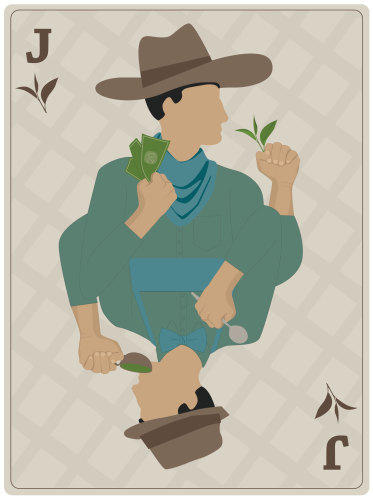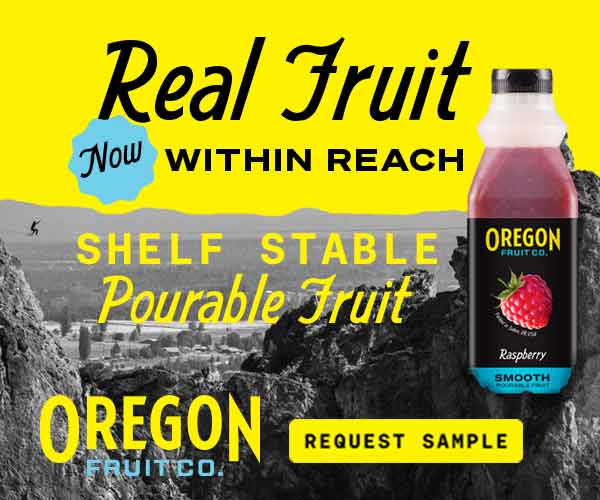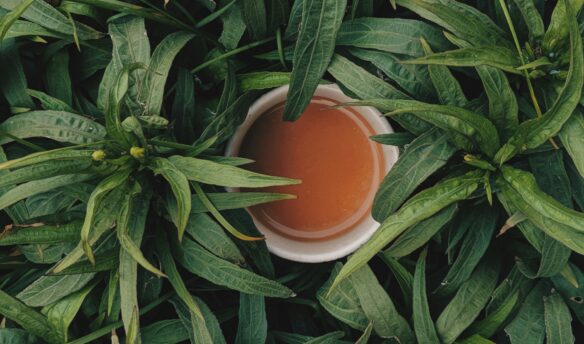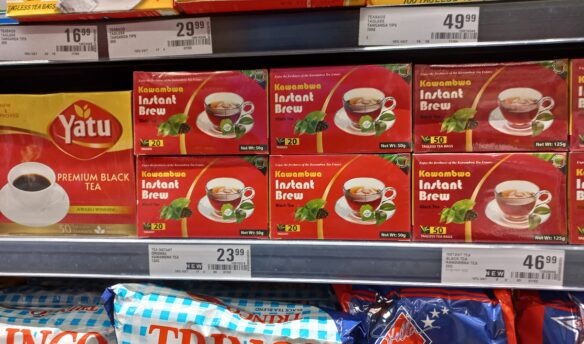[B]efore building In Pursuit of Tea, a company focused on buying leaves directly from the world’s finest producers, Sebastian Beckwith was working in the adventure travel business, specializing in the Himalayan Mountain regions around Sikkim, Nepal, and Darjeeling. “I brought some tea back for friends and then thought ‘I should just do this,’” he says. The travel work was an ideal segue into the tea business. “I had some contacts in Taiwan; I went over to Japan. I was able to easily travel.”
Today, many tea entrepreneurs hope to follow a similar path and source teas directly from growers around the world. Some are drawn by the allure of journeying to the most remote corners of the globe in search of unique or rare teas that will delight and inspire others. Others wish to become part of a more sustainable tea industry, one that preserves the communities and environments that produce these teas. Direct trade offers this, along with better control of quality, prices, and the ability to show transparency to customers.
While direct trade holds these undeniable benefits, building a successful business rooted in this time-consuming and laborious practice is far more complex than one might expect. The normal systems of brokers, wholesalers, and importers emerged for a reason. There is typically a secret to the success of traders like Beckwith, such as a job involving international travel in Asia, family at origin, or heavy financial backing. With so much to master, it is wise to spend time learning from the experiences of those who have decades in the trade before buying a ticket to Kolkata or Kagoshima in search of tea.

Manik Jayakumar is the founder of QTrade Teas & Herbs, one of North America’s leading importers of USDA organic and Fair Trade-certified teas. He’s seen plenty of tea companies go to origin and find the wrong partners to work with. “Sometimes the vendor is such a small company,” he says. “Someone claims they’ll ship to the US but then they cannot get a registration number, for example. The vendor should have experience exporting teas or they’ll send it in a carton that is not strong enough, for example. It is not easy; it takes a while for people. Eventually people give up and try to work with people who have lots and lots of experience.”
Mo Sardella is a tea educator, GS Haly’s director of marketing, and a deep fountain of tea industry knowledge. He sees the recent widespread interest in the direct-trade model as a boon for innovation, but encourages newcomers to the trade to respect the tradition and standards that the tea industry was built on by learning the ropes before running wild with creativity. Innovation for its own sake can lead to unnecessary complexity and a departure from consistency, thus negatively impacting the trade as a whole.
He gives jasmine pearls as an example. “Before pearls were a thing, Yin Hao jasmine was considered to be the best,” he says. “Once the pearl phenomenon took place, it became hard to find good Yin Hao jasmine because all the material was being diverted into pearl production. Sometimes pearls are of high quality. Mostly though, it’s a bandwagon thing. Everyone was making pearls and some were really bad.”
Europe and other tea-focused cultures have maintained a basis of expectation for traditional teas while also adding on a higher focus on quality.
Sardella believes in tasting frequently to gain authentic tea know-how. “There are no short cuts. You have to cup your teas often, not treat it as a five to ten percent increment of business, but a real growth potential.” Attaining true tea knowledge requires years of study, dedication, and practice. And not just of the tea cultures of Asia. Sardella encourages tea professionals to study cultures with an older tea tradition than America’s for inspiration. “Europe and other tea-focused cultures have maintained a basis of expectation for traditional teas while also adding on a higher focus on quality,” he says. That’s a great model balancing traditional views of quality but also pushing the tea to new levels.
It is often assumed that buying direct will ensure the highest quality tea and in some instances it can. When you travel to origin, you are able to taste thousands of teas, not a handful that have been chosen by brokers or importers. You also can work with farmers to craft a custom lot of tea to your specific requirements. This is fun, creative, and inspiring, but doing this for each of your dozens or hundreds of teas is unrealistic without a team of buyers, a large budget, and years of experience. Beckwith says, “Buying direct doesn’t mean you’ll get the best product and if you require blending, that is left out of that equation. It’s a big skill set to have.”
It is common for a less experienced tea buyer to choose teas based on looks alone, rather than on the actual quality and taste of the tea. Here again Sardella encourages more cupping and a respect for tradition. “Tea people need to cup tea more often to learn about what quality is in the cup, not value by their eyes,” he says.
Tea people need to cup tea more often to learn about what quality is in the cup, not value by their eyes.
It is true that buying direct will allow you to purchase tea for a lower price. After all, you will have no middlemen to pay. But the price paid to the producer is just the beginning. You’ll end up doing all the work of the importers, traders, and tasters, then there are import costs, taxes, and other charges to consider. By the time the tea reaches the warehouse, you might have spent an additional $1–$20 per pound of tea, depending on the volume of tea purchased.
Regular travel is essential to learn about tea from garden to cup, develop trustworthy relationships, and to establish credibility among your clientele. This can easily cost over a quarter of a million dollars annually, depending on the teas you are offering and the amount of time you will be spending in tea-producing countries. That cost must also be weighed against the cost of being away from your business at home.
[A]part from ample capital and tea knowledge, volume of tea sold will be a deciding factor in the success of any direct-trade tea model. If you can purchase a container load of tea from an export dock, then the costs associated with importing will be very reasonable and you will likely be making the returns necessary to support your business. It is also feasible to import partial container loads or to air freight small quantities if you are focusing on higher end teas that can support the additional freight charges. On the flipside, Sardella says, “When you get to a certain volume or quality point, it can be hard to maintain a direct-trade model.” Your demand may outstrip your direct-trade supply.
Lastly, you will want to be mindful of the increasing number of regulations over food imports. According to Jayakumar, even QTrade Teas finds new rules and regulations “a real nightmare.” “There are [producing] countries that use a lot of pesticides and cannot comply with new US regulations. There are fourteen items that need to be tested in the US,” he says. “We have people with masters degrees in biochemistry. We invest in people who can interpret these readings.” Add to this the paperwork associated with certifications and memberships from food safety to Fair Trade, USDA organic, and Ethical Tea Partnership and you have enough work for a full-time position.
[I]f you are considering a move into direct trade, remember that a strictly direct-trade model is virtually non-existent among tea retailers. “Most people buy some direct and then get most from importers,” says Beckwith.
A major reason for this is that some origin countries are not set up to support direct trade. “It’s really difficult to find a true direct trade model in traditional origins like Sri Lanka and Japan because of the historic model that has been set up,” Sardella says. “For example the auction system in Sri Lanka is a good way for producers to get real value for their teas based on merit not garden mark. These [tea standards] are filters put in place to qualify products and give them value, which has been good for importers.”
If you are considering a move into direct trade, remember that a strictly direct-trade model is virtually non-existent among tea retailers.
Consider a unique selling model or specializing in one region. Boston Tea Campaign has achieved both by selling only Darjeeling teas and only in relatively large package sizes for true Darjeeling aficionados. Additionally, they offer teas for pre-purchase. This model keeps their prices down and volumes up. It also narrows their focus on one area of the globe, which minimizes their need to travel, and supports producers with pre-season purchase agreements; hence financial stability.
Another avenue to explore would be to choose whether you would like to be an importer, a buyer, or a retailer, rather than being a mash of all three. Then, you will not have to acquire the skill set of each endeavor and will more easily become a master of one rather than a novice of many. This has been the approach of a tea start-up called Tealet. Founder Elyse Petersen says, “We decided to build Tealet as a platform for the industry because we have no intention of becoming a large tea retail brand or chain.” Their focus, virtual tea brokering, allows the company to stay agile and minimize risk while learning about the tea and its trade. Petersen says, “We have gone through a few iterations of the platform and have learned a lot through our mistakes.”
Understanding your motivation is a good starting place for entering the world of direct-trade tea. If you desire to travel, learn, and teach, then you can do so but still use a broker or importer to procure teas, even ones that you have chosen yourself. Over time and once you know the ropes, then buying certain teas directly might be a natural evolution. If making a difference and interacting with local cultures is your pull there are numerous ways to have a positive impact and organizations like Ethical Tea Partnership, Fair Trade, Rainforest Alliance, and myriad others can assist your efforts. If you are an entrepreneur at heart and dedicated to directly traded tea, then jump in, choose an innovative business model, enjoy the journey and reach out to those who are considered masters when challenges arise.
—Sarah Scarborough is a tea blogger and writer and the owner of Firepot Chai.

















